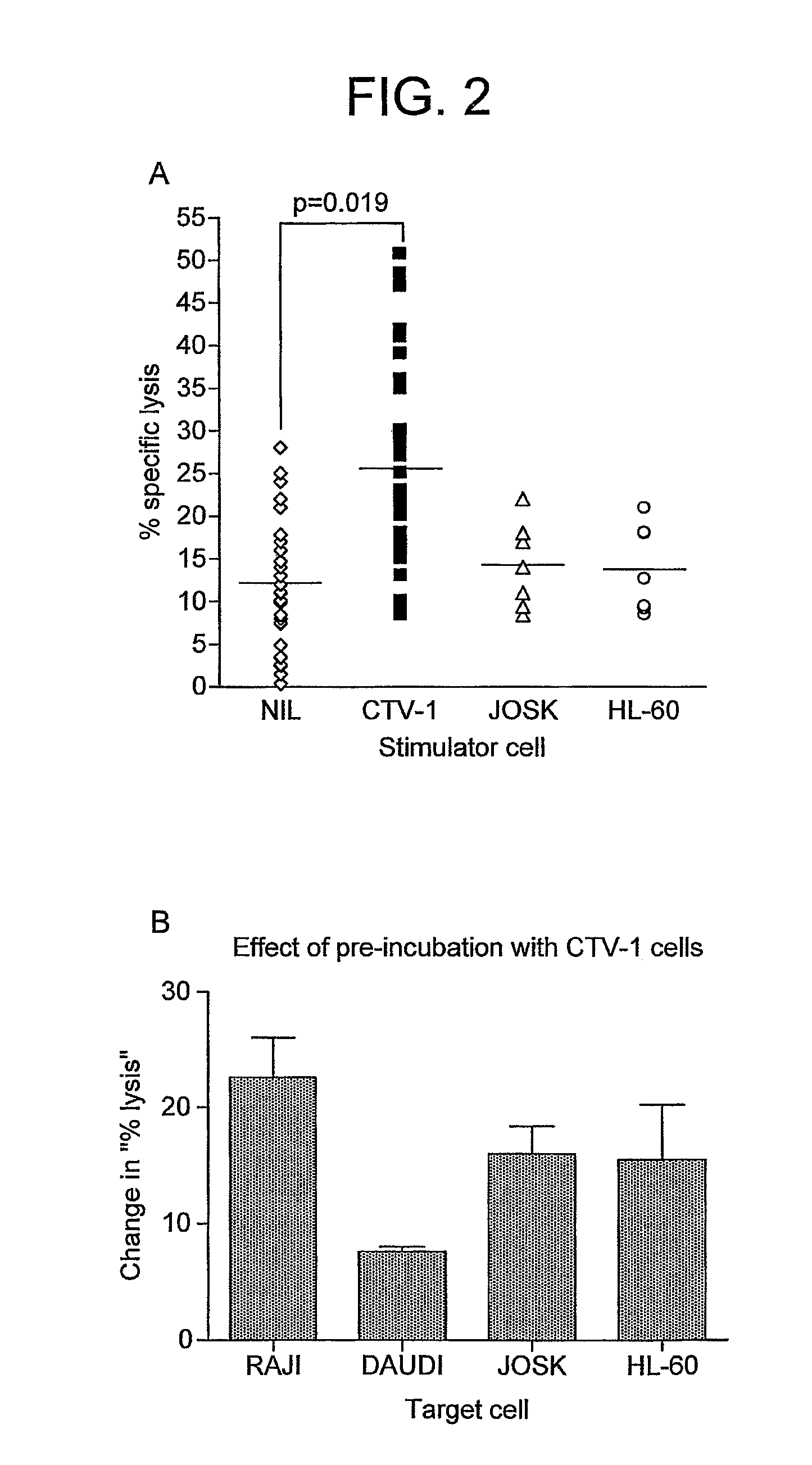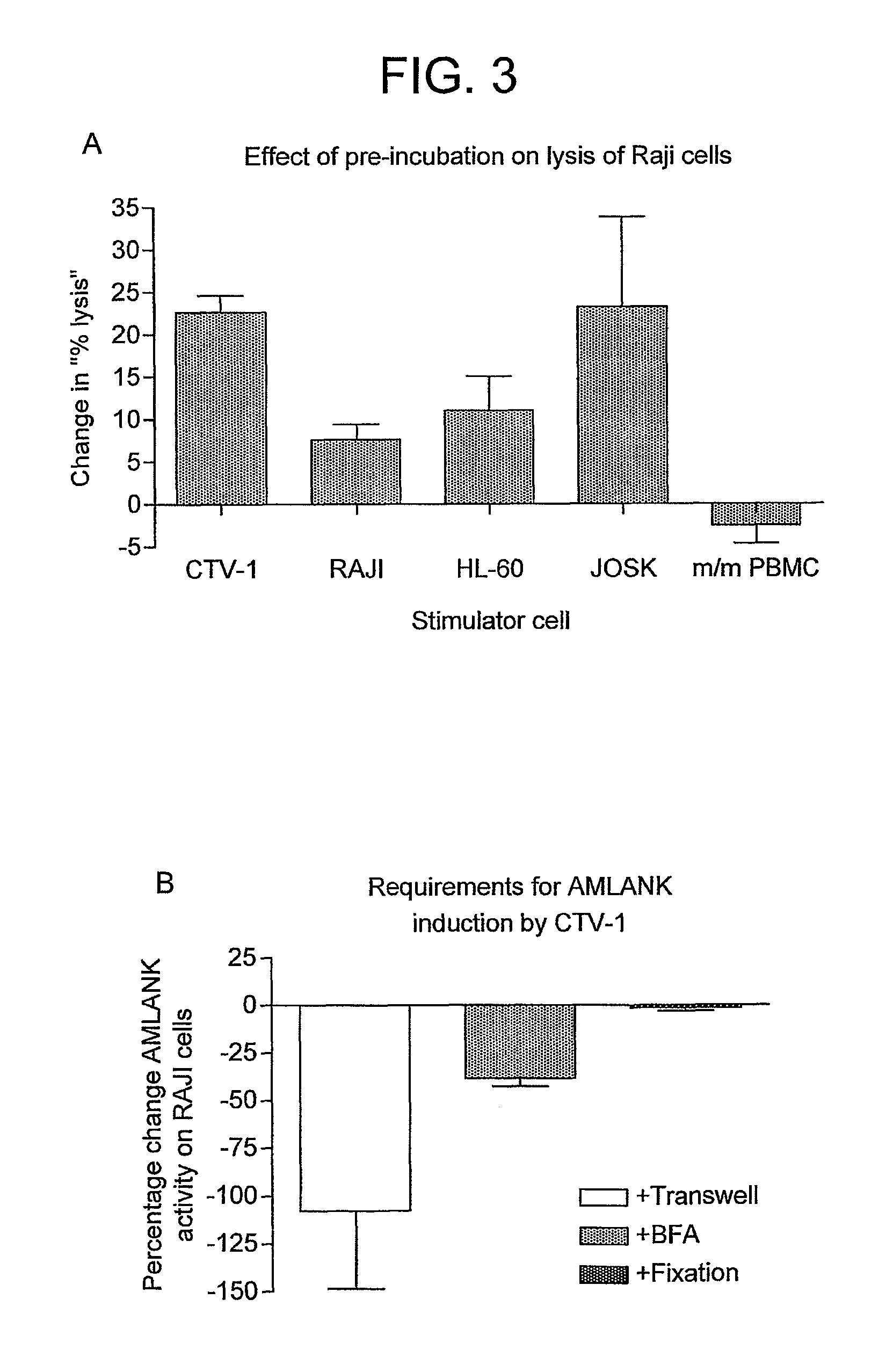Method for activating natural killer cells by tumor cell preparation in vitro
a natural killer and cell technology, applied in the field of natural killer cell activation, can solve the problems of a significant proportion of patients relapse following treatment, limited efficacy of chemotherapy, and poor clinical efficacy, and achieve the effect of less likely to resul
- Summary
- Abstract
- Description
- Claims
- Application Information
AI Technical Summary
Benefits of technology
Problems solved by technology
Method used
Image
Examples
example 1
Pre-Incubation of NK Cells with Certain Tumour Cell Lines Significantly Increases the Degree of Lysis of NK-Resistant Cell
[0128]Pre-incubation of normal donor NK cells with CTV-1 cells very significantly increases (p3A and 4A). CTV-1 cells are “activating tumour cells”.
[0129]Pre-incubation with HL-60 (FIGS. 2A, 3A and 4A) or Raji cells (FIGS. 3A and 4A) are less effective or ineffective in activating the NK cells to lyse Raji cells. Pre-incubation with allogeneic HLA-KIR mismatched normal PBMC does not induce NK activation (FIG. 4A). In these experiments, the tumour cells express normal levels of MHC class I antigens as do the Daudi and Raji cell lines. Daudi and Raji cells both express HLA-C molecules which ligate both class 1 and class 2 KIRs.
[0130]Pre-incubation with CTV-1 causes an increase in the degree of lysis of various tumour cell-lines, such as Raji, Daudi, JOSK and HL-60 (FIG. 2B).
example 2
Investigating the Requirements for NK Cell Activation
[0131]The effect of fixation and Brefeldin A (BFA) on NK activation by CTV-1 cells is investigated using multiple normal donors. As shown in FIG. 3B, induction of NK activation requires contact with the tumour cell line although does not require secretion of a cytokine since fixation of the tumour cells does not abrogate the response. The NK cells do need to synthesise a protein in response to the tumour cell ligation as addition of Brefeldin A during the pre-incubation prevents induction of the activated state.
example 3
Investigation of the Effect of KIR Ligation
[0132]In order to investigate the effect of KIR ligation during the stimulation phase, the use of HLA-KIR matched and mismatched stimulating tumour cell lines is compared on the stimulation of NK cells to lyse Raji cells. The stimulating tumour cell lines need not be HLA-KIR mismatched to the donor NK cells although it appears that the threshold for NK activation by the tumour cell line may be lower in the absence of KIR ligation (FIG. 6A).
[0133]In another experiment, purified NK cells from normal donors are selected on the basis of their HLA-A, -B and -C type as KIR-ligand matched or mis-matched with CTV-1 cells. CTV-1 cells are HLA-C type 2 homozygous and express HLA-Bw4 alleles. They thus ligate KIR2DL1 and KIR3DL1 on NK cells. NK:CTV-1 co-cultures are established with NK cells expressing KIR2DL1, expressing KIR2DL1 and KIR3DL1 and with cells expressing only KIR2DL2 / 3, the ligand for which is missing from CTV-1 stimulator cells. It is th...
PUM
| Property | Measurement | Unit |
|---|---|---|
| activation time | aaaaa | aaaaa |
| activation time | aaaaa | aaaaa |
| pH | aaaaa | aaaaa |
Abstract
Description
Claims
Application Information
 Login to View More
Login to View More - R&D
- Intellectual Property
- Life Sciences
- Materials
- Tech Scout
- Unparalleled Data Quality
- Higher Quality Content
- 60% Fewer Hallucinations
Browse by: Latest US Patents, China's latest patents, Technical Efficacy Thesaurus, Application Domain, Technology Topic, Popular Technical Reports.
© 2025 PatSnap. All rights reserved.Legal|Privacy policy|Modern Slavery Act Transparency Statement|Sitemap|About US| Contact US: help@patsnap.com



